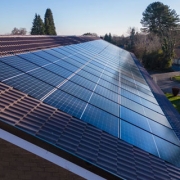Kingspan unveils new QuadCore Lower Embodied Carbon range – QuadCore LEC
QuadCore LEC has been developed specifically to help reduce the carbon footprint of the buildings it is used on. Using comparative Lifecycle Assessment Data (LCA) data to the EN15804-A2 standard, this breakthrough in insulated panel technology demonstrates a 41% reduction* in embodied carbon in modules A1-A3 (product stage) for QuadCore AWP in a 100mm thickness. The first products in the QuadCore LEC range will be in available in Q1 2023 in the UK and Irish markets.
Further reductions in the embodied carbon of the QuadCore LEC range are expected between now and 2030 and are underpinned by the business commitment to Net Zero Carbon manufacturing by 2030, the introduction of an internal carbon charge, and the investment in H2 Green steel – a company pioneering the manufacture of steel using hydrogen instead of fossil fuels.
Mike Stenson, Head of Innovation for Kingspan Group explained “As a business we are committed to developing high performing, energy efficient, building envelope solutions that help minimise the carbon footprint of buildings over the whole life cycle. Creating products with reduced embodied carbon and enhanced potential for circularity is key to achieving this.
QuadCore is already one of the highest performing insulation technologies in terms of thermal efficiency (underpinned by a 25-year thermal warranty) which could enable higher energy and carbon savings through the operational life of the building. This is the first step on our journey to reducing the embodied carbon of our products and we anticipate some major milestones by 2030 to drive that down even further.”
The new QuadCore LEC insulated panel range will have all relevant independent testing and certification for UK & Irish markets.

*Quadcore AWP LEC LCA shows a 41% reduction in LCA modules A1 – A3 (product stage) when compared to existing Quadcore AWP LCA to the EN15804-A2 standard for a 100mm thickness. The LCAs for QuadCore KS1000RW and QuadCore Coldstore are currently going through the verification process and EPDs (Environmental Product Declarations) will be published ahead of the products launching in Q1 2023. The 41% reduction is achieved through raw material changes. When comparing modules A-C (product stage, construction process stage, use stage, end of life stage) the overall reduction is 17%.
FOR MORE INFORMATION ON QUAODCORE TECHNOLOGY PLEASE CLICK HERE TO EMAIL KINGSPAN
UK: +44 (0) 1352 716100 IRE: +353 (0) 42 9698 500
CLICK HERE TO VISIT THE KINGSPAN WEBSITE






